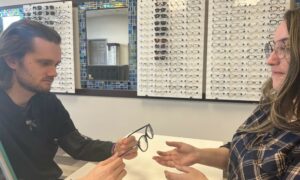 Selling complete new eyewear is both a challenge and an opportunity, according to findings from The Vision Council’s September 2014 Consumer Barometer report. Some 9.4 percent of respondents say they are “extremely likely” to buy a complete new pair of prescription eyewear in the next six months; 15.4 percent say they are “very likely” to buy complete Rx eyewear, while 23.1 percent say they “might or might not” make such a purchase. Twenty-five percent say they will “probably not” make a purchase of complete new Rx eyewear, and 27.1 percent say they will “definitely not.”
Selling complete new eyewear is both a challenge and an opportunity, according to findings from The Vision Council’s September 2014 Consumer Barometer report. Some 9.4 percent of respondents say they are “extremely likely” to buy a complete new pair of prescription eyewear in the next six months; 15.4 percent say they are “very likely” to buy complete Rx eyewear, while 23.1 percent say they “might or might not” make such a purchase. Twenty-five percent say they will “probably not” make a purchase of complete new Rx eyewear, and 27.1 percent say they will “definitely not.”
Do you pre-set patients to purchase new eyewear? The most effective way is for the doctor, in the exam room, to examine the patient’s current eyewear pointing out all flaws found. “I see your current eyewear has a couple of scratches on the lenses, your nosepads are yellowing and there is a small crack in the left temple … these will make great back-up glasses for you.” You’ve now planted the thought in the patient’s mind that their current eyewear has some problems, and that they will be getting new eyewear.
Another effective pre-setting conversation is to talk about high-definition televisions. Most people have upgraded to a high-definition television. During your conversation with the patient, casually confirm this. This sets up the conversation about the change in their prescription from their current prescription. You definitely want to watch high-definition TV through high-definition glasses.
The problem in many practices is the lack of training and, therefore, the lack of effectiveness in the Close. The Close is where the patient accepts the treatment plan. This is really where the patient either gets the care needed or does not.
To become effective in the Close, start your training here. Make sure both the doctor and the optician understand and are able to effectively use what is called the Presumptive Close technique. Sometimes this is also called the Assumptive Close. Once this technique is mastered, then you can move on to other Close approaches to master them, as well.
Your action plan for this week is to review how both the doctor and optician are trained to help patients get the care needed. The two areas to focus on this week are pre-setting patients and the Close. Fix these two areas and watch more patients get better care in your practice.

























